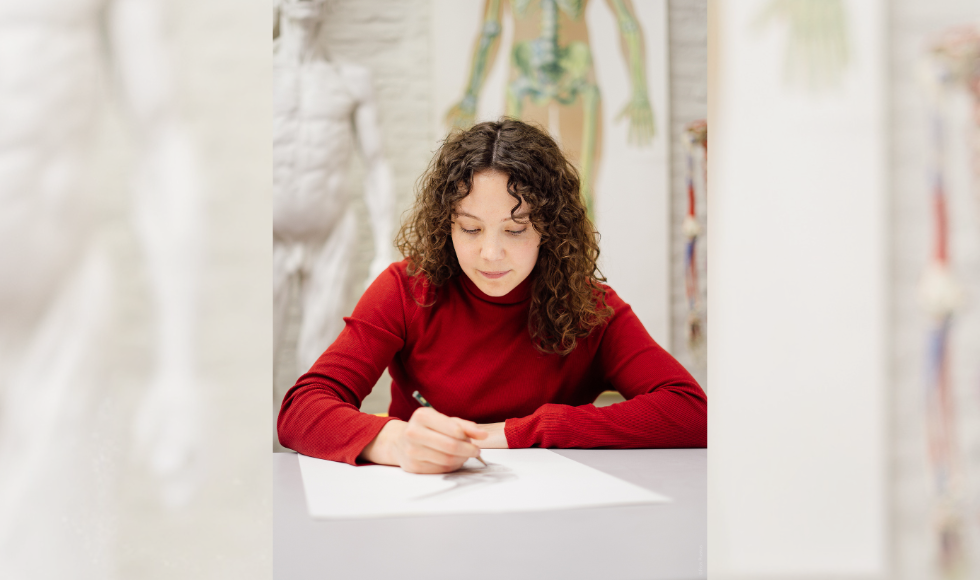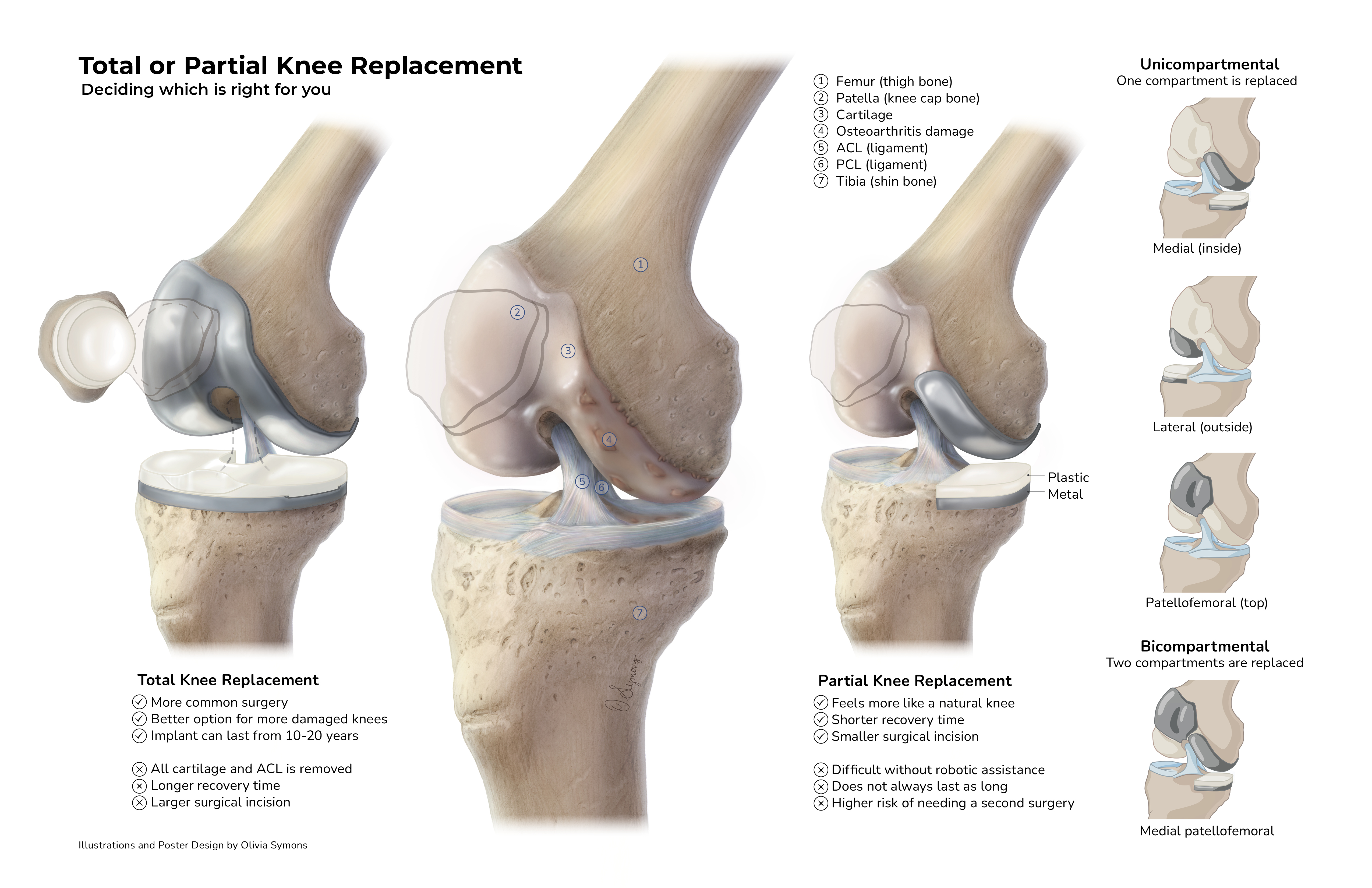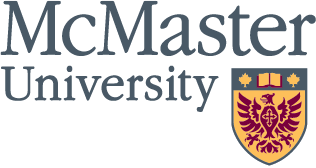Kinesiology grad finds her calling as a scientific illustrator

Olivia Symons uses illustrations to make science more accessible. Her work being put to use to help patients understand both their treatments and the research behind them.
Dissecting a knee at a medical centre in the Netherlands brought Olivia Symons back to Mac.
Symons performed the dissection as a scientist, artist and student in the Master Scientific Illustration program offered by the Faculty of Health, Medicine and Life Sciences at Maastricht University and Zuyd University of Applied Science.
“Knee deep in my dissection, I discovered a new perspective that forever changed my understanding of anatomy,” says Symons. “Knowledge that used to be confined to flat textbooks was now at my fingertips.”
She used that new perspective to draw an exploded view of a posterior left knee. Symons aced the assignment and found the inspiration for her graduation thesis project. She’d visualize innovative treatments for knee osteoarthritis – a chronic condition that exacts both a physical and emotional toll on one in seven Canadian adults.
Olivia Symons’ digitally coloured graphite illustration depicts an exploded view of a posterior left knee. Olivia says medical and scientific illustrations like “Knee Deep” are a visual form of communication in which illustration and artwork are used to convey medical and scientific concepts to a specific target audience. Target audiences can range from specialists in a given field, medical professionals, students and the general public. Olivia says illustrations are powerful as they make science more understandable, transcend language barriers, and often depict what words cannot. “In scientific illustration, accuracy is crucial and it requires a strong foundation in both artistic skill and scientific knowledge so the illustrator can collaborate with researchers, scientists, doctors and other experts.”
Symons knew exactly where to find new and novel treatments – as a kinesiology undergrad at McMaster, she’d spent four years surrounded by groundbreaking research in the department and across the university. It’s also where she found her calling as a scientific illustrator.
Symons had always been a creative kid. Give her a pencil and a sheet of paper and she would happily spend hours drawing. But she quit being that kid in high school. Art was relegated to a hobby while Symons went all-in on STEM courses.
Like pretty much every science student at university, she briefly thought about medical school. She instead followed her curiosity and discovered her dream career as a scientific illustrator.
For Symons, combining art and science to communicate research was the ideal way to earn a living and make a difference.
Symons recognized early on that scientists could use some help from artists. “Communication is especially important when it comes to breakthroughs and novel treatments – people don’t just need to understand the research, they need to trust the science and the scientists.”
Knowing who and what to trust is getting harder to do in our age of generative A.I., says Symons. “There’s a flood of A.I. images being used to peddle misinformation. Scientists, medical professionals and scientific illustrators have a responsibility to cut through the noise. We need to be the trusted sources that people turn to when they’re making important decisions about their health.”
After graduating from McMaster in 2022 where it was all science and no art, Symons spent a year studying art fundamentals at Sheridan College where it was all art and no science.
She got to bring those two worlds together at Maastricht and Zuyd Universities. Many apply to their scientific illustration grad program but few are chosen – just eight students are accepted each year. Along with its stellar reputation, the program had the added bonus of letting Symons spend two years living and learning in Europe.
Putting science illustration to work
To find collaborators and novel knee osteoarthritis treatments to illustrate, Olivia religiously read every McMaster Daily News and Brighter World story. She found three potential external supervisors – Kim Madden, Dylan Kobsar and Matthew Rosato.
Madden is an associate professor of surgery and a research affiliate at the Research Institute of St. Joe’s Hamilton. St. Joe’s is revolutionizing surgical treatment for knee osteoarthritis by performing robot-assisted partial knee replacements.
Kobsar is an associate professor of kinesiology who leads the Kobsar Biomechanics Lab. His lab is using cutting-edge motion capture to create more personalized and effective treatments for people with knee osteoarthritis.
Rosato is a two-time Mac grad who’s the president and founder of PROVA Innovations. His medical technology start-up at the McMaster Innovation Park is developing smart insoles to reinvent gait rehabilitation.
All three welcomed Symons to put her science illustration skills to work for patients and clients, and gain experience working in industry, medicine and academia.
She began working on her thesis by sitting in on orthopaedic surgeries in the Netherlands and at St. Joe’s. You can’t communicate what you don’t understand, says Symons. It helps that she has a strong stomach. “Surgery can get quite gory.”
Eight months worth of thesis work culminated in a stand-out presentation to faculty and classmates – and her science illustrations were also framed and featured in a public exhibition at the Natuurmuseum in Tilburg, Netherlands.
Most important of all, her illustrations are being used by Kim, Dylan and Matthew to help educate patients and clients.

“Olivia demonstrated an impressive ability to engage with our work,” says Kobsar, who admits he didn’t initially know what to expect from working with a scientific illustrator.
He says the team in his lab invests a lot of time and effort creating materials to help patients understand both their treatments and the research behind it. “While written explanations are essential, visual communication can be even more impactful. Whether it’s clarifying procedures before a study or conveying findings afterwards, visuals like the ones Olivia created for us are increasingly vital to scientific communication.”
Kobsar says he’s not surprised that a senior professor at Symons’ defense said her illustrations were the best he’d ever seen in his career. “Olivia’s final illustrations for our research group are outstanding.”
Working with Symons was a “wonderful experience,” says Madden, who’d never previously thought about teaming up with a scientific illustrator.
“After brainstorming some ideas with Olivia, I now see how useful it is to have someone who’s so skilled at science communication using visual storytelling,” Madden says. “Olivia created illustrations for patients to help them visualize complex surgical concepts – that’s something patients love and it helps them better understand the surgeries they’ll be receiving. Olivia’s work is both beautiful and informative, combining great creativity and scientific knowledge.“
Symons graduated in June and just returned from a European vacation with her parents. Having found and trained for her dream career as a scientific illustrator, Symons is now looking to land her dream job.
At the top of her wish list is creating illustrations in service to science at a leading research-intensive university.
Like the novel treatments she illustrated in her graduation thesis, Symons knows exactly where she’d like to do that work.
To connect with Symons, or to get explicit permission to use the scientific illustrations in this story, please send an email to oliviafsymons@gmail.com.


